
Before his brief stint as Star of the Show- a role he resigned from as he became a Living Legend- Bravo was the Showstopper. This Welcome to Rathe hero boasts easy access to dominate, which adds an element of inevitability to his attack suite that no other Guardian can replicate. Bravo can also harness the power of crush effects extremely effectively.
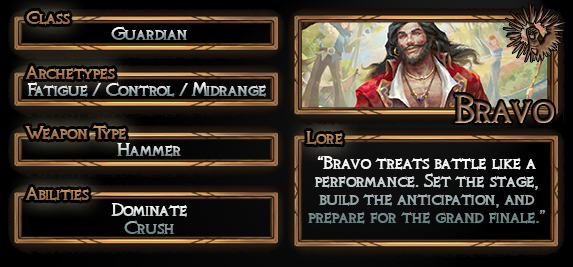
The core gameplay of the Guardian class involves throwing one large attack at a hefty cost. This requires a heavy investment in blue cards, in order to generate enough resources to pay for your attacks. At first pass, this feels like an inefficient way to build a deck: you've filled out your list with less powerful versions of your cards, which not only lessens your damage output but also undermines your chances at hitting those crush effects.
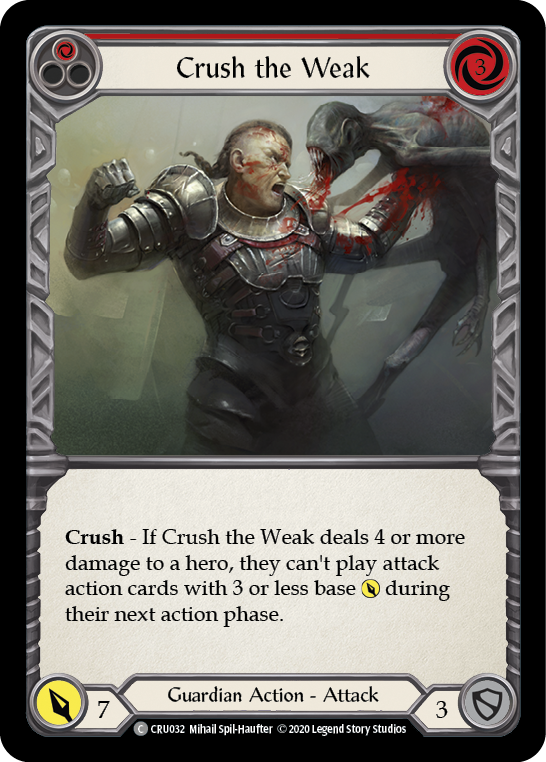
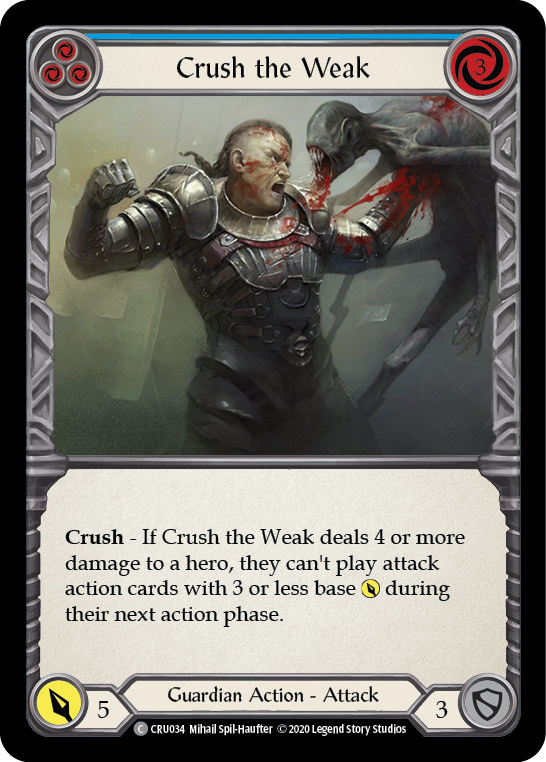
But building Guardian requires a different mindset. With such high costs on your cards, pitch value is now a premiere selling point- most of the cards you draw into will be used to generate resources. Even when you don't hit one of your key attacks- the ones you're running in red because you intend to throw them at your opponent whenever you see them- Bravo will often choose to pitch and swing his hammer, Anothos, rather than play one of those blue attacks.
A Special Relationship With A Hammer

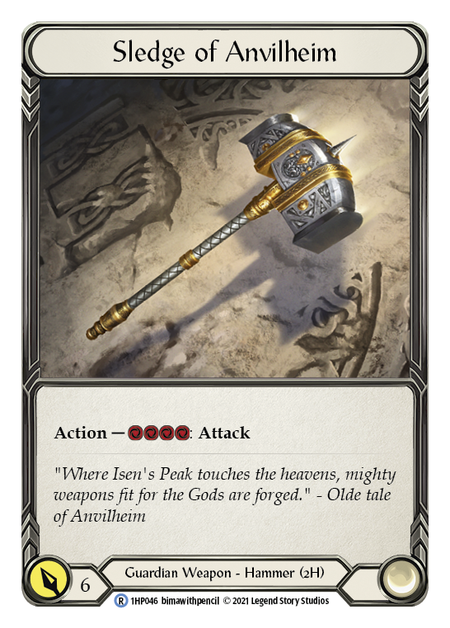
(I included Sledge for the sake of completeness; but Bravo has a clear favorite.)
The role Anothos plays in a Bravo deck is second in prominence only to a Warrior's weapon. The hammer is Bravo's constant companion, the go-to attack that every card in hand needs to out-perform if it wants to get played. Swinging your weapon preserves cards in your deck- you're attacking without sending a card to your graveyard- which contributes to Guardian's inherent aptitude for fatigue strategies. Anothos hits for 4 at its base level, which is already a breakpoint attack; but if you've pitched two cards with costs of 3 or more, it jumps up to 6.
Applying continuous pressure with your hammer is a strong core strategy. Every swing for 6 requires 2 cards to block it out fully. This not only wears out your opponent's deck over the course of a game, but also limits their options to attack you back from a 2-card hand.
Dressed for the Fight
To get two cards into your pitch zone on a turn swinging Anothos, you'll usually have to find additional costs- and it's best when they have benefits for you. In a pinch, you can pitch to Bravo's ability, but it isn't compatible with a hammer attack. This is why Tectonic Plating remains a fixture of Bravo decks.

There is decidedly a benefit to spending a resource now to save one on your next turn. Some of Guardian's best attacks cost 7 resources to throw, meaning a single Seismic Surge token is the difference between pitching 2 cards and pitching 3. But in many cases, Tectonic Plating is simply triggered to give an outlet to another pitched card.
Tip: If you can't spring for a Legendary right now, Bravo can also see serious benefits from equipping the Everfest majestic Earthlore Bounty. A Bravo deck with Earthlore Bounty will want to focus more on Guardian effects that draw cards, such as Auras; and as a synergistic bonus, Auras with go again are a great way to pitch a card before swinging Anothos!
Beyond the chestplate, the Guardian equipment is primarily built for defense. Guardians have some of the densest armor in the game! Even without legendaries, Bravo can stride into a fight with 8 points of defense at no cost- and 10 if he's willing to pitch for Ironhide Helm and Legs. Even when equipment has other effects available, its primary role in Guardian is to take a hit- so don't expect to actually use Crater Fist's effect.

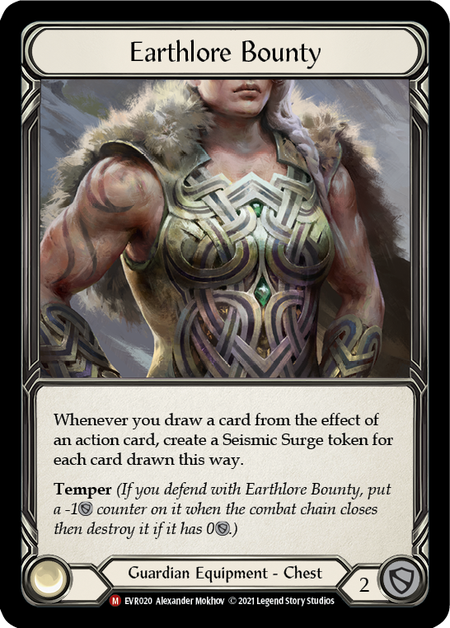
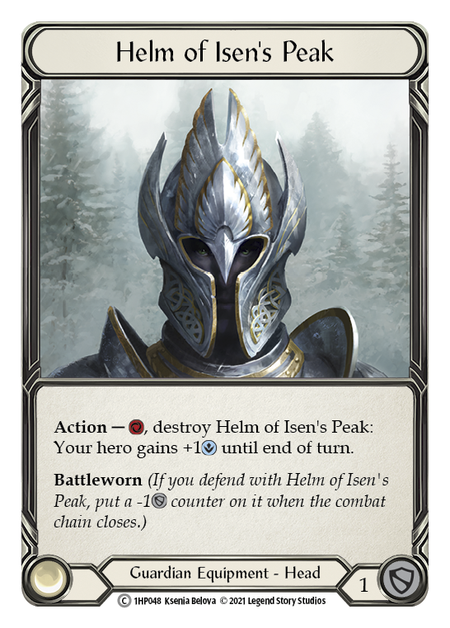
What's more, Guardians are the first class to have access to off-hand equipment, a slot that becomes available once you equip a one-handed weapon like Titan's Fist. While Rotten Old Buckler exists, it's Rampart of the Ram's Head - or, for the budget conscious, Steelbraid Buckler - that truly belongs in this slot. These shields add additional defensive options to your deck- though as a more aggressive Guardian, Bravo is unlikely to opt for this approach at the expense of Anothos!
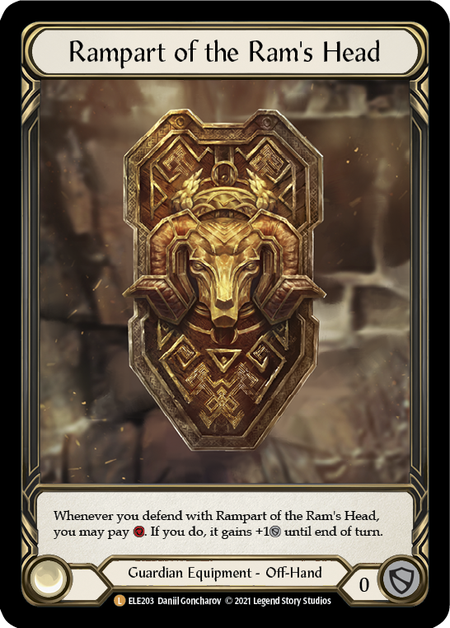
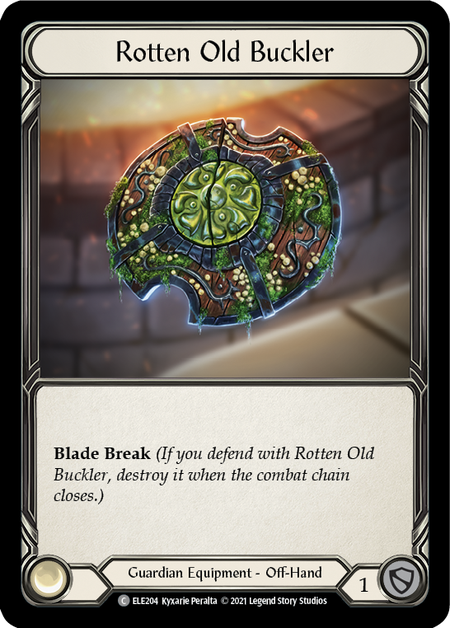
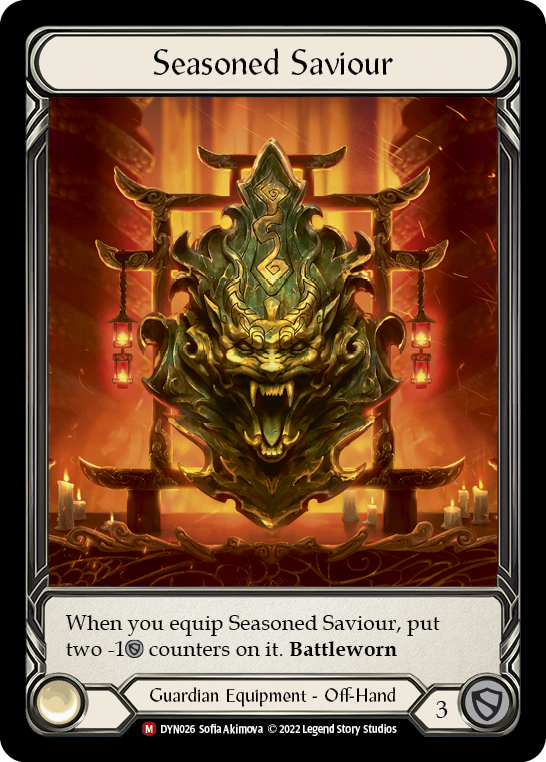
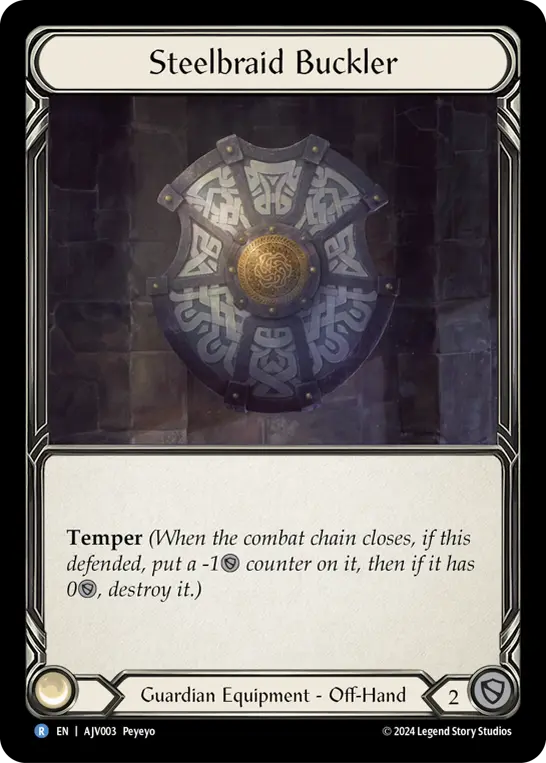
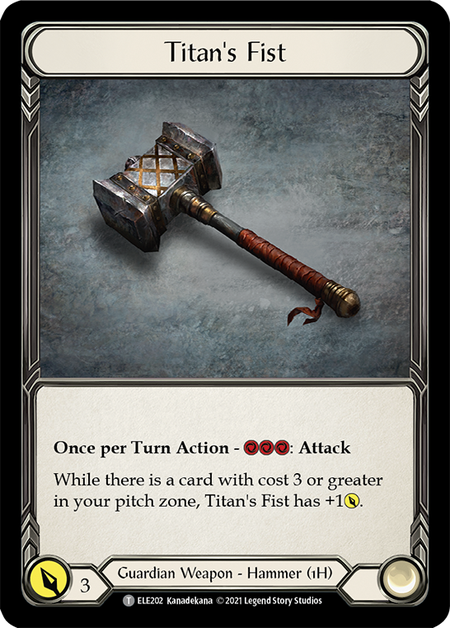
A shield strategy is developing in the fringes of the class, thanks to an influx of Dynasty cards supporting off-hand equipment. We'll discuss this more below.
Showstopping Hits
A Bravo deck is comprised of a small selection of key attacks (usually run in red for maximum impact) and a large pool of supporting cards (in blue, because you need to pay for things). Yellow cards have very limited application in a typical Bravo deck.
So what are the key attacks? Some of this is a response to your local meta, but there are a few 'staples' that form the backbone of most builds.
We have to start with Bravo's specialization: Cripping Crush. This card sports a double-digits attack value and a devastating crush effect; with its cost of 7, it pairs perfectly with Bravo's ability for a dominated attack that costs you 3 blue pitches to play.
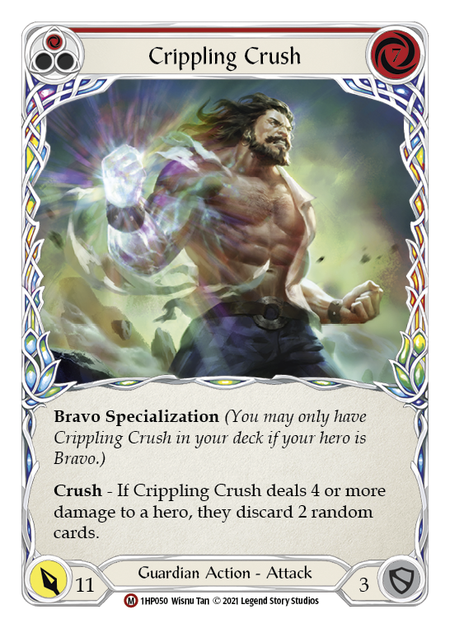

Spinal Crush has been its constant companion, also debuting in Welcome to Rathe and only 1 card deeper down the set list. Its absolute ability to remove go again as an option for your opponent can be devastating to go-wide and setup decks alike. While that 5 is much less elegant than 7 for optimized pitching, it does pair with a Tectonic Plating activation for 6 resources.
The more dangerous line of play, however, is to pitch 3 blues, activating Bravo and playing Spinal Crush with 2 resources left floating. This sets you up for a reaction with Pummel- an important tool in Bravo's game plan. Even the threat of Pummel forces an opponent to play differently. And with so many blues in your deck, it's seldom a sacrifice for you to pitch 2 extra resources solely to bluff a reaction.


Disable, like Spinal Crush, comes in at 5-cost, and its crush effect targets the arsenal in a fashion akin to the generic celebrity Command and Conquer. Unlike Crippling and Spinal, Disable comes in a full cycle of colors- it's often used at both red and blue in a deck, with the blue still dealing enough damage to make its crush effect a legitimate threat when dominated.
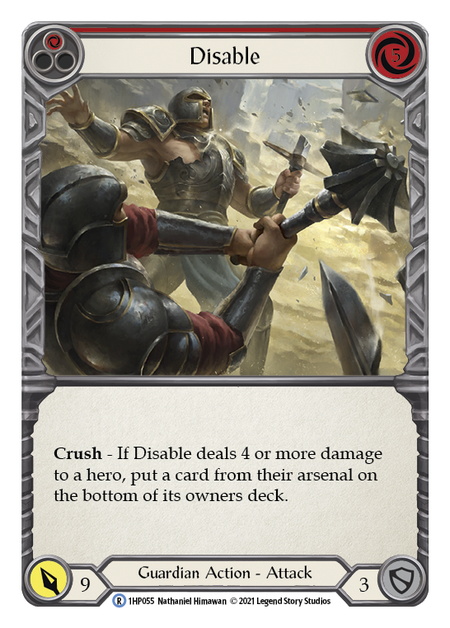

The staples thus far all appeared in the very first set, and have always been tied to Bravo's game plan. But Pulverize is a newcomer, making its debut in Everfest. The upside of a 14 attack is offset by risk: playing this card typically requires that you arsenal it with a heave (pay 3 resources now, then discount it by 3 due to the Seismic Surges that trigger at the start of your next turn), and if you can't swing another 7 resources next turn your arsenal is locked down until you can pay its full cost. Pulverize is an incredibly tempting attack, but it's not right to play into every opponent. A hero like Katsu can read the opening you created and make you pay if you skip blocking to hold resources; and then if you do hit them with Pulverize, they'll swing a Kodachi for -3 and move on with their turn unhindered.
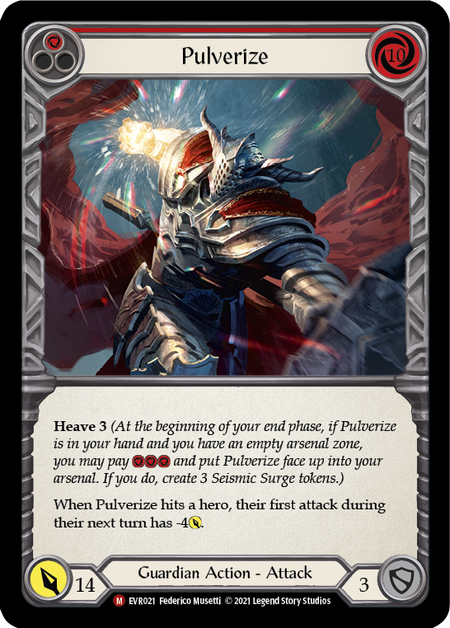
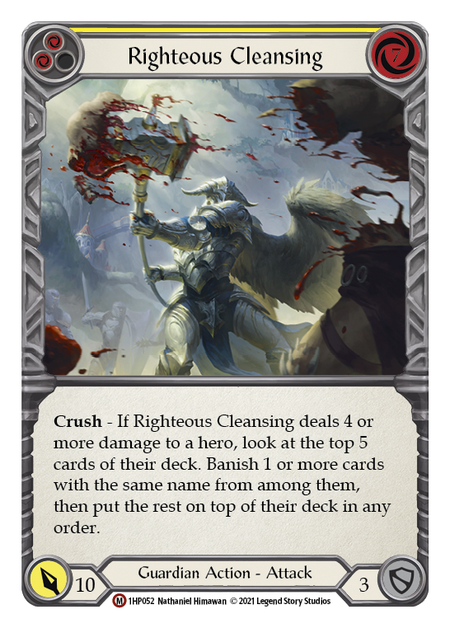
On the edge of the 'staples' designation, Righteous Cleansing comes in at that same 7-cost that worked so elegantly for a dominated Crippling Crush. Righteous Cleansing is notable for its ability to banish a card (or multiple copies of that card, if they show up together); but while less glamorous, the information you gain from knowing the hand your opponent will draw next turn is perhaps even more valuable.
Supporting Roles
Any supporting role could also be considered an understudy. These cards have useful effects and are often attacks we're happy to throw, should the opportunity present itself. Many of them could be elevated to a primary role, if your local meta is particularly vulnerable to their effects. When you see that the blue card's base attack is 5 or 6, you know the red version comes in at 7+, ideal for triggering crush when dominated.
Crush the Weak interferes with strategies that prioritize quantity over quality. Similarly, Chokeslam locks in attacks at their base damage, undercutting efforts to buff weak cards and sidestep the higher costs of inherently larger attacks. Rangers, Ninjas, Runeblades, and Mechanologists can all be targeted by escalating these cards from supporting blues to starring reds.


The ability to counter a hero power remains a rarity, so having such an effect available in the Guardian toolkit is notable. Crush Confidence can be a major stumbling block for a hero like Chane, Dorinthea, or Boltyn- and is catastrophic to Levia.

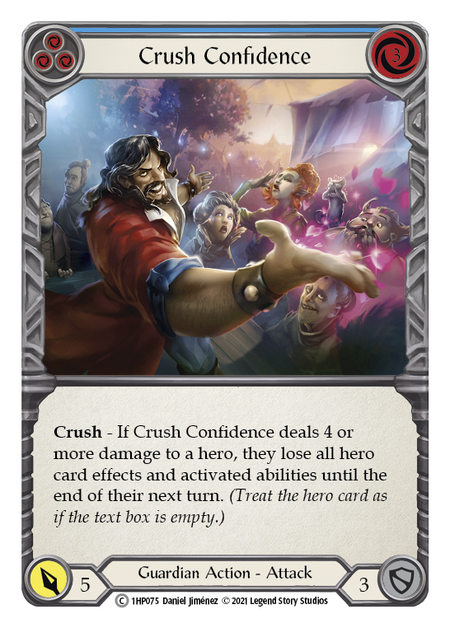
It may sound strange to categorize Cranial Crush as a supporting card, but with its blue pitch value it truly is pitched more often than played. There will be some opponents against whom you'll prioritize playing this attack out- Lexi comes to mind as someone whose biggest turns happen because of extensive card draw- but the card's biggest advantage comes from being flexible between both roles without having to build your deck specifically for the role you anticipate needing it for.
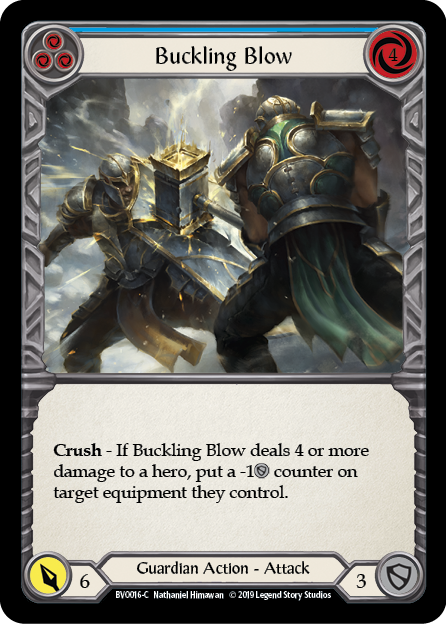


Buckling Blow, Debilitate, and Cartilage Crush are seldom seen above blue- their effects just aren't valued as starring roles at this time- but they're often included simply to increase your count of blue Guardian cards that cost 3 or more. Any blue can threaten its crush effect with a Pummel, so don't write them off as filler; but most often, these cards are going to fuel your hammer swings or pay for the priority attacks you do want to play.
Building Suspense
Guardians have a surprisingly deep Aura game- a sub-type of non-attack actions that stay on the battlefield for a predetermined amount of time and either grant effects by sitting in play or when they're destroyed. Thematically, this is the 'showmanship' element of Bravo: that wind-up before a bit hit, that taunt before engagement, that wink to the audience or comical pause to take a drink before continuing the fight.
Auras play an important role in helping Bravo spend resources across multiple turns. The delayed payoff is the only way a Guardian can truly afford to play any sort of lead-in before firing off their high-cost attacks. Many buff an attack on your next turn; others improve your defenses while you take a turn off.
Like your supporting attack actions, auras often serve a primary role as pitch cards- especially those with a cost of 3 or greater.
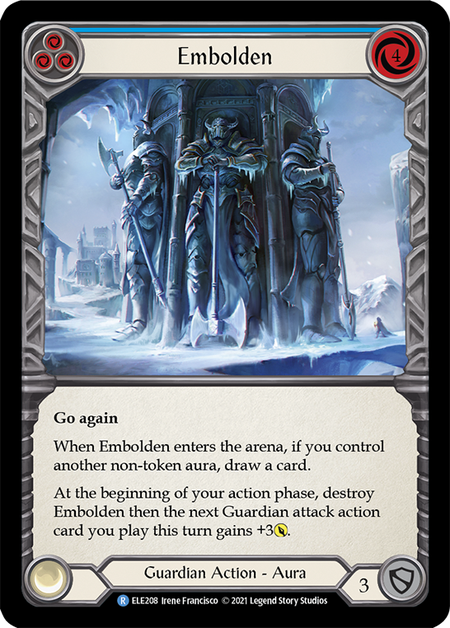
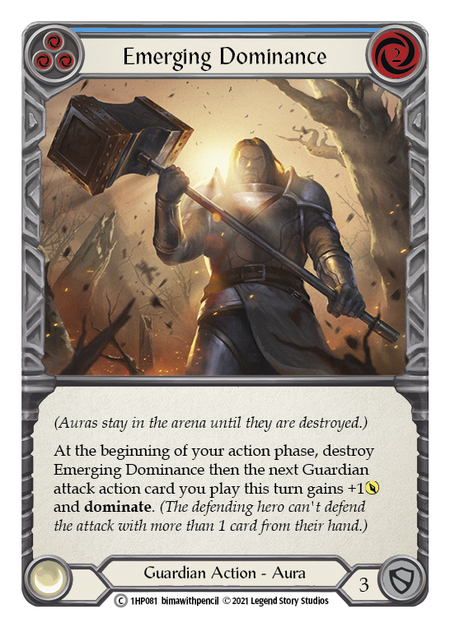
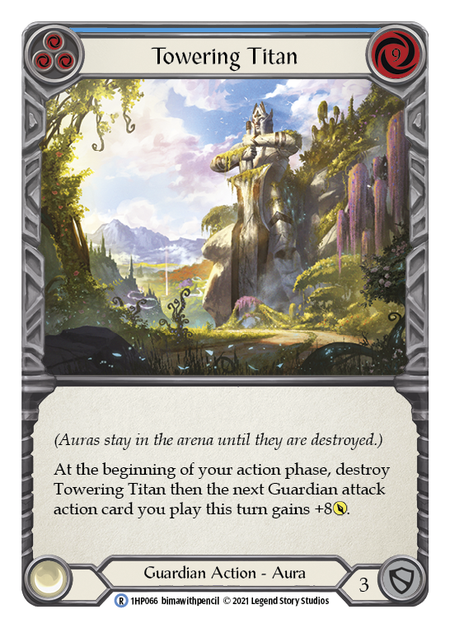
The 'buff' auras include Emerging Power, Emerging Dominance, Embolden, and Towering Titan. The Emerging cards don't have the best synergy with a conventional Bravo deck; their cost of 2 fails to trigger Anothos in the pitch pile, their buffs are minor, and Emerging Dominance is redundant of Bravo's hero ability. Embolden provides a more significant buff, and may have synergy with a decklist more focused on auras.
Towering Titan is the most notable on the list, as its buff basically doubles the power of any attack action card Bravo is likely to throw. In most games, however, you'll never actually play the card, using it for pitch or block instead; 9 cost is expensive, and there's a real risk that your next hand will contain no guardian attacks to buff- or that skipping your defense to facilitate that is too costly!
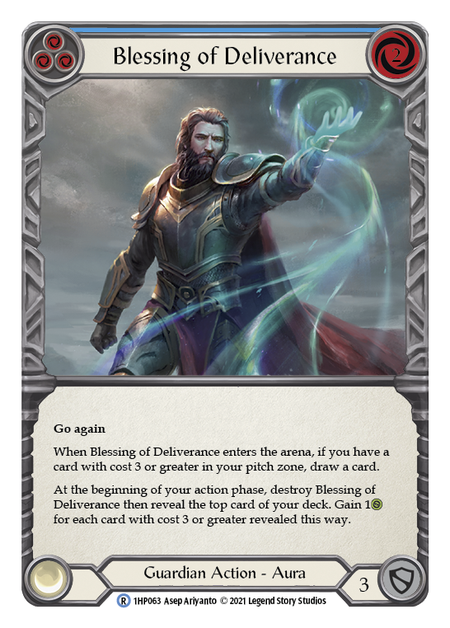
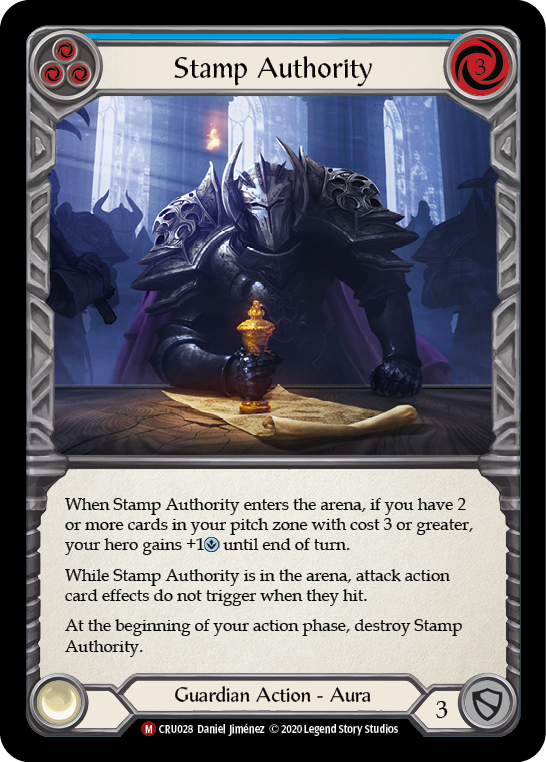
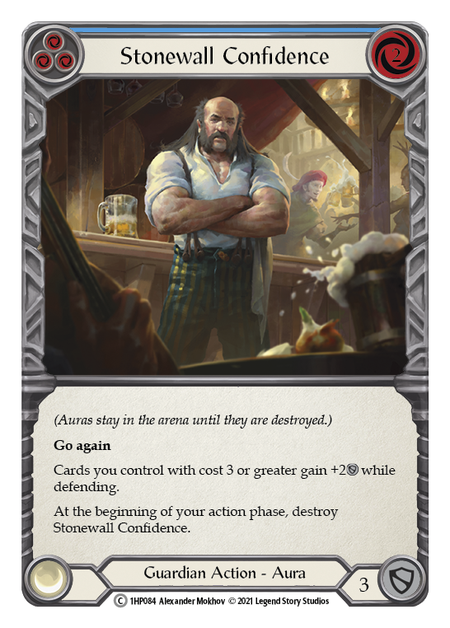
The defensive auras tend to focus on improving your next turn by taking pressure off on the defensive. These can give you some breathing room to hoard enough resources for Crippling Crush, Righteous Cleansing, or similar high-cost plays.
The most straightforward of these is Stonewall Confidence. This card aims to make a single-card block entirely sufficient, leaving you with a 3-card hand on your next turn. Often the sight of a Stonewall is enough to deter a big play from your opponent.
Similarly, Stamp Authority strips opposing attacks of on-hit effects, while possibly giving you a 5-card hand for your next turn. This is dependent upon your ability to get 2 cards into your pitch zone, so look for outlets to pitch ahead of playing Stamp Authority.
It can be hard to see the full value in Blessing of Deliverance, especially as experienced players will steer you toward the blue-pitch version as the superior card. That's why I've placed it after Stamp Authority, a card that can clearly benefit from a Blessing of Deliverance played ahead of it. Pitch a blue with cost 3+ to pay for this, and it replaces the pitched card with a fresh draw- and leaves you with 1 resource floating. Small actions like these go a long way in Bravo, even before we consider the minor benefit of life gain on your next turn.
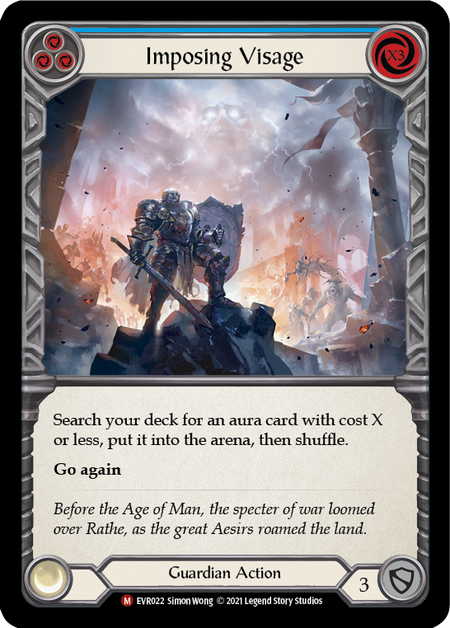

Tutors- or cards that search your deck for something- remain a rarity in Flesh and Blood; and because of the value of pitch stacking to late-game fatigue strategies, you may not even want to search your deck due to the shuffle required afterwards. Guardians have two such cards: Imposing Visage, which lets you pull a key aura from your deck, and Show Time!, which finds an attack action plus draws an extra card at the start of your next turn. Nerves of Steel (which isn't actually an aura, but is intrinsically tied to aura strategies) is largely a future-facing card, primed for strategies that aren't fully formed yet. And while many choose not to actually play Show Time! during the course of a game, it still makes the decklists because it's blue and it blocks; and besides, sometimes you just really need that one particular attack to close the game!
Stage Blocking
Thus far we haven't discussed blocking at all, but make no mistake: Bravo does block. Because he can always fall back on Anothos, Bravo has no qualms about dropping 3 cards on the defensive, saving a single blue to swing back for 4.
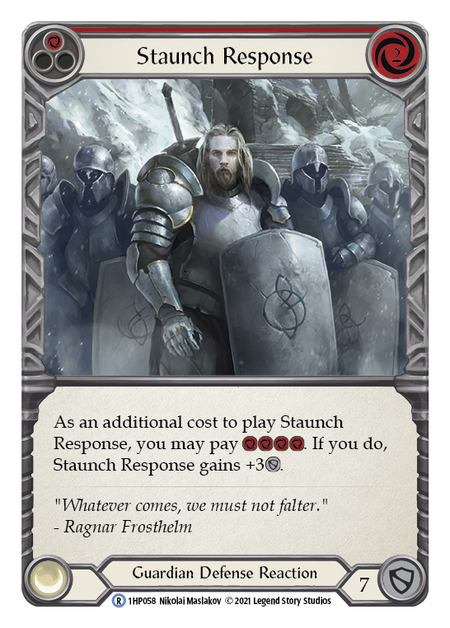

It's not asking much of Bravo to pay for a defense reaction either. If Bravo can block 5+ damage while only losing 1 card from his deck, he's happy to do that. Staunch Response, in red, can block for 7 with 1 card pitched; if you pitch two blues, it blocks 10! Not only is that above rate for your average card's defense value of 3, it also sends most of those cards back into your deck, meaning you're not falling behind in the war of attrition.
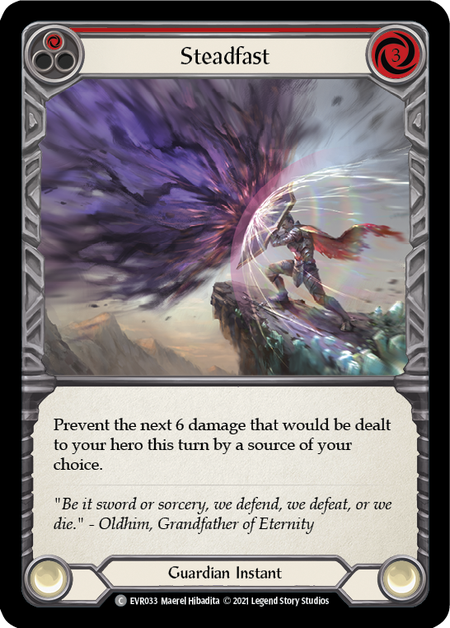
Lest you think Guardians are only strong in the physical realm, allow me to introduce Steadfast to the conversation. This card serves as a versatile defense against tall attacks- or even multiple attacks from the same source, such as a Warrior's Dawnblade. More importantly, it's a defensive tool for the Wizard matchup, as it can be used to block arcane damage.
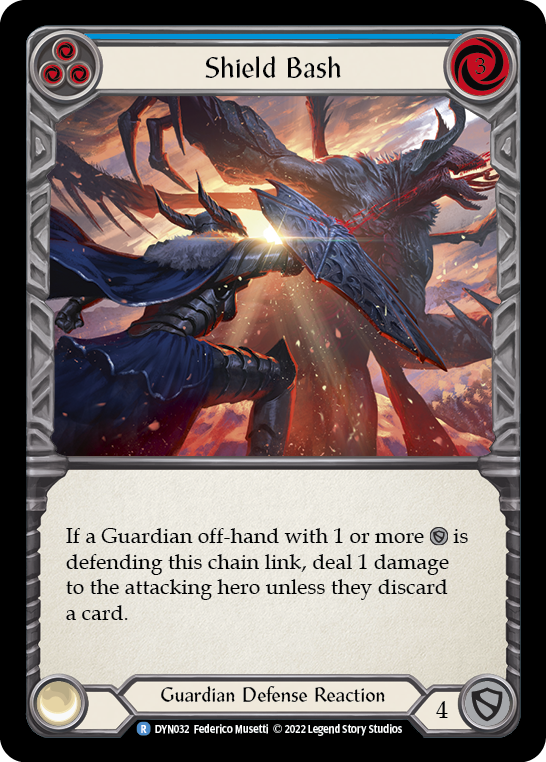
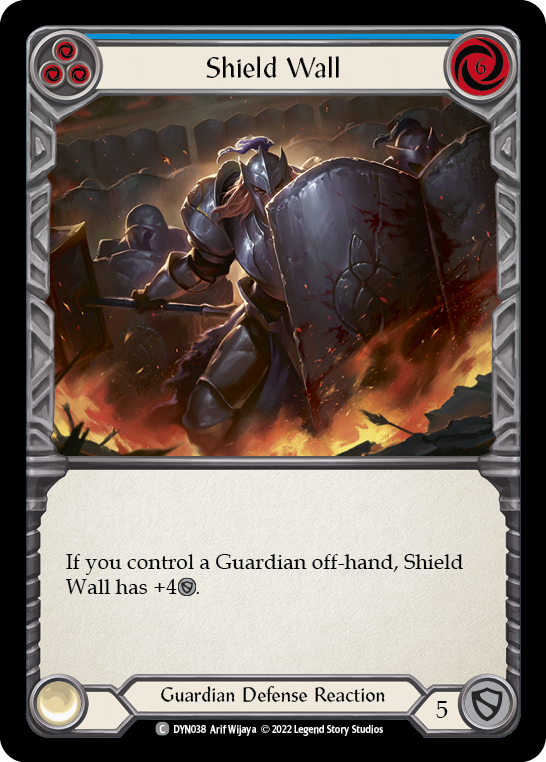
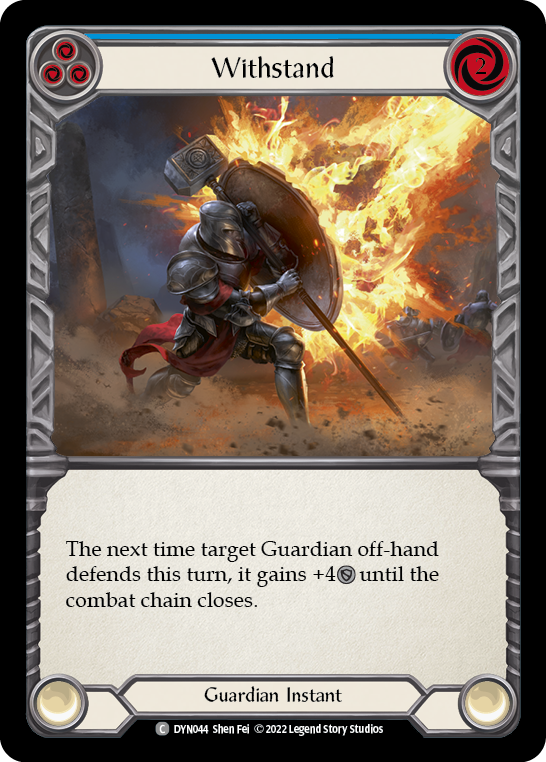
There are also incredible defensive tools available for those who want to hold back on the hammer in favor of a shield. Shield Bash gives Guardian a way to close games on the defensive, while Shield Wall and Withstand offer massive blocks from single cards, contingent on your shield being ready.
You can keep that buckler fresh with a new suite of equipment-reviving cards like Reinforce Steel and Never Yield. In fact, it should be mentioned that an armor package exists in the form of Forged for War and Nerves of Steel. These cards may one day form the basis for a strong 'no blocks from hand' strategy that inspires Bravo to leave Anothos at home and take up the Ram's Head shield instead. But for the time being, they remain a novelty that deserves more support and exploration.
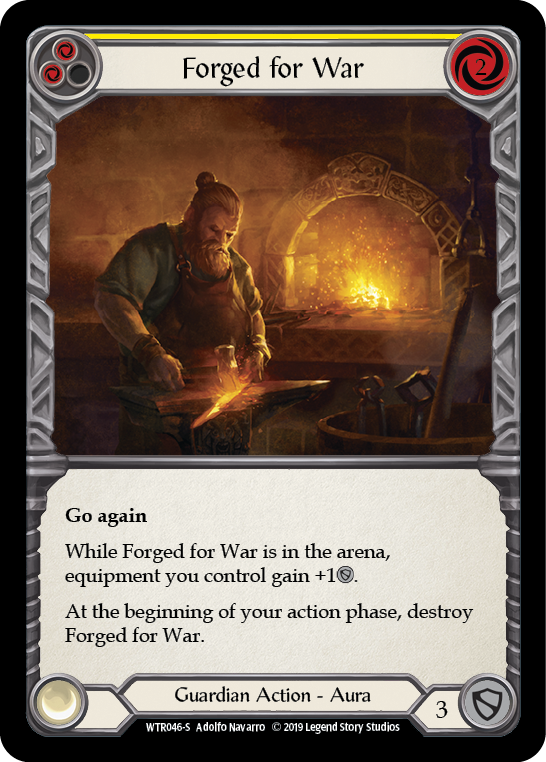
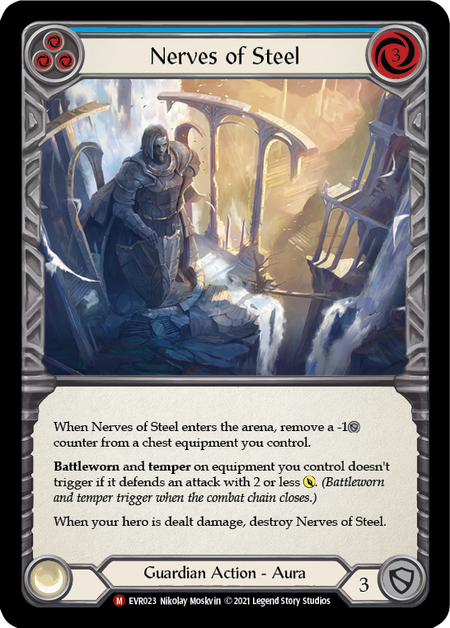
Guardians love their armor, but in that Wizard match, you should be sure to have Arcane Barrier in your sideboard. Nullrune equipment is a staple, but Guardians can also choose to equip Titan's Fist with an Arcane Lantern in their off-hand, if they so choose. However you get there, be sure to bring 3 instances of Arcane Barrier: 1, as Bravo often pitches blues and you'll want to get the full defensive value out of that.
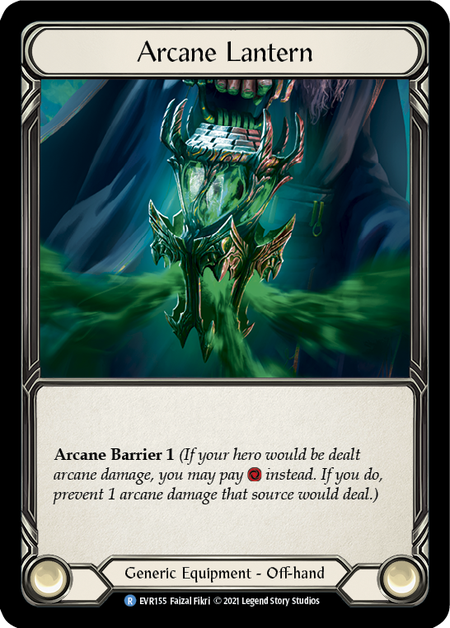
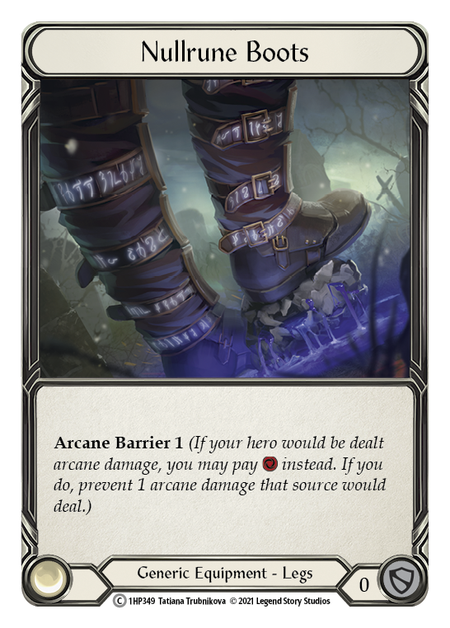
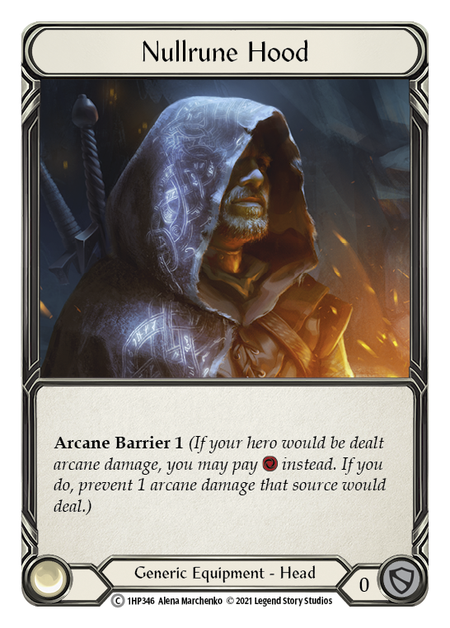
Props
Guardians do quite well with the card pool available within their class, but they do have a few notable favorites in the generic card pool as well. Many of these cards are used to add a little spice to your list- most Bravo players wouldn't use all of them in one list.
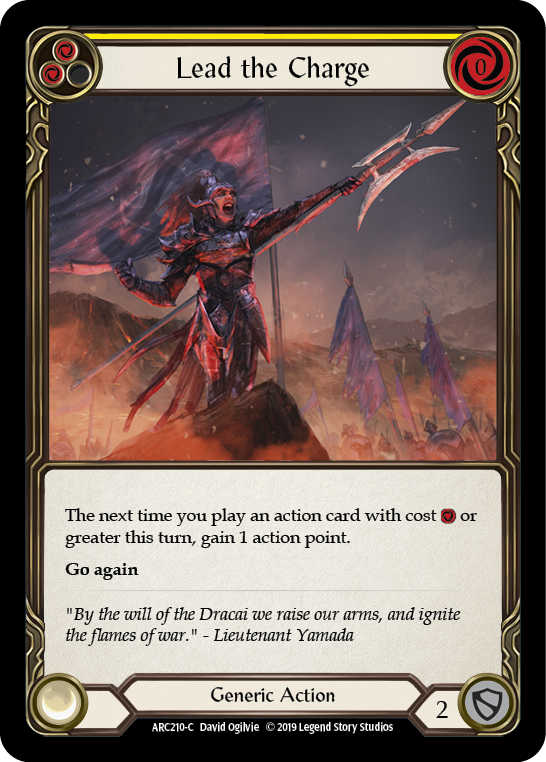
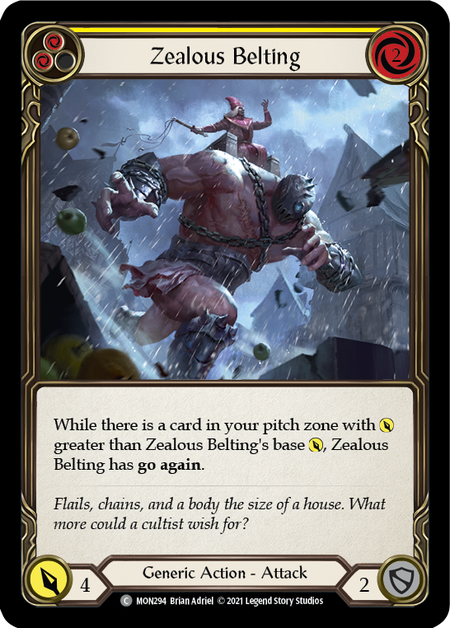
Yellow cards may not have much of a role to play in Bravo's strategies, but they can be an important consideration into one of his worst matchups: Prism. Because of the Great Library of Solana, it's not a bad thing to have a few extra yellows in the deck. And because of Prism's aura game, we can appreciate having a few extra actions. Both of these cards accomplish that, letting us continue our aggressive gameplan while also addressing a Spectra aura on the way out.


Potions pitch blue, which is a top-level benefit when venturing outside of our class. But when we have an action available to put one of these potions in play, it's exceptionally useful to have an action- or some resources- stored up for a future turn. Timesnap Potion is another tool in the war against Aura Prism, while Energy Potion can constantly threaten a Pummel just by existing.
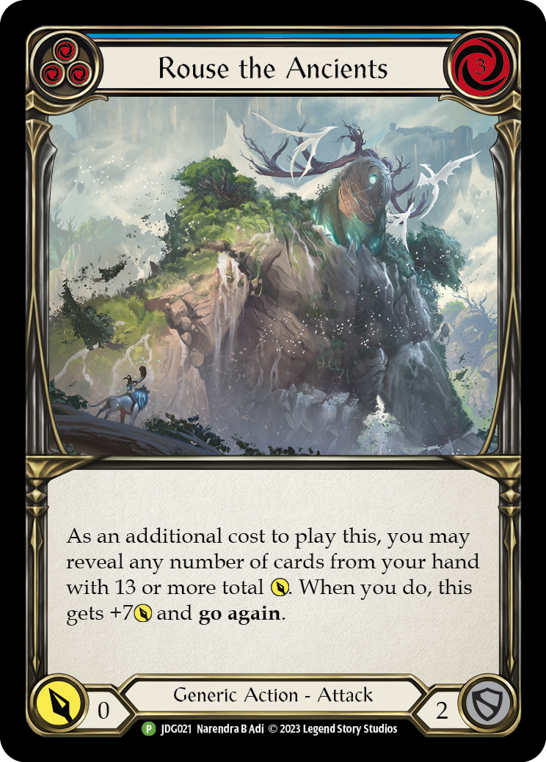
Rouse the Ancients' +7 attack trigger is pretty easy for Bravo to fulfill, but it's the go again that really sets it apart. Without considering attack options from hand, a 7 from Rouse rolls nicely into a 6 from Anothos (because you've probably pitched 2 blues with cost 3+). More importantly, any change in your attack pattern forces your opponent to reset their assumptions about how they should defend in the future.
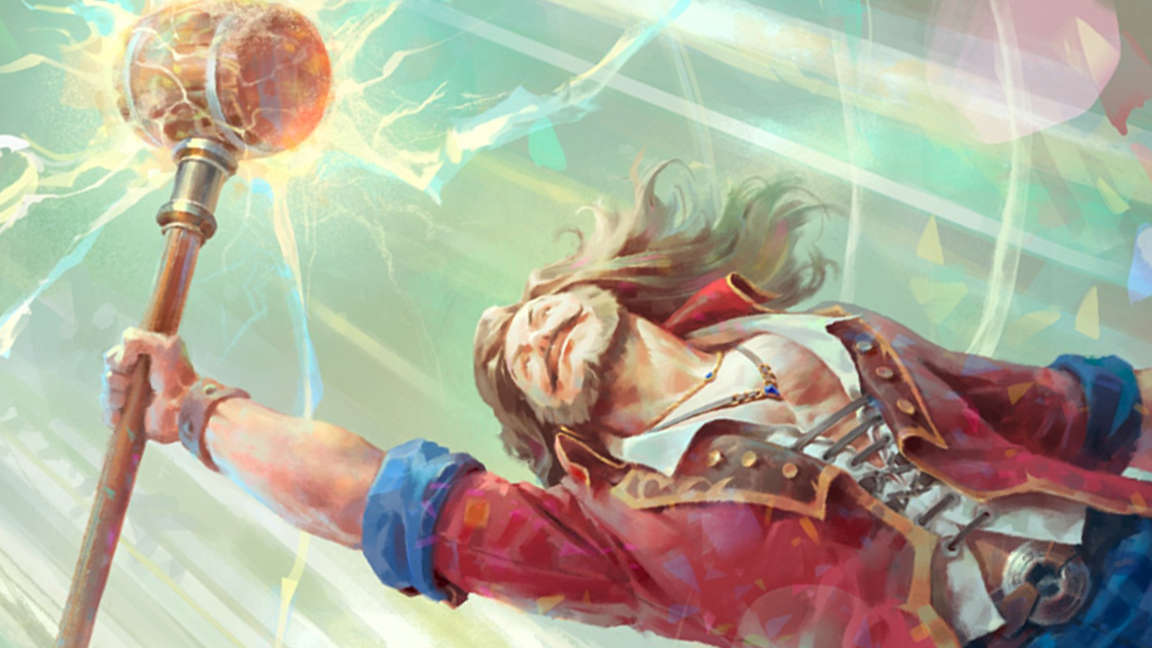
Those who played FaB during the Everfest era may know Bravo best for his tri-colored Elemental affinity. But even before he tapped into his latent potential, Bravo was always the star of the show. His laid-back tempo serves to accentuate his huge hits and ensures he can always go another round.




